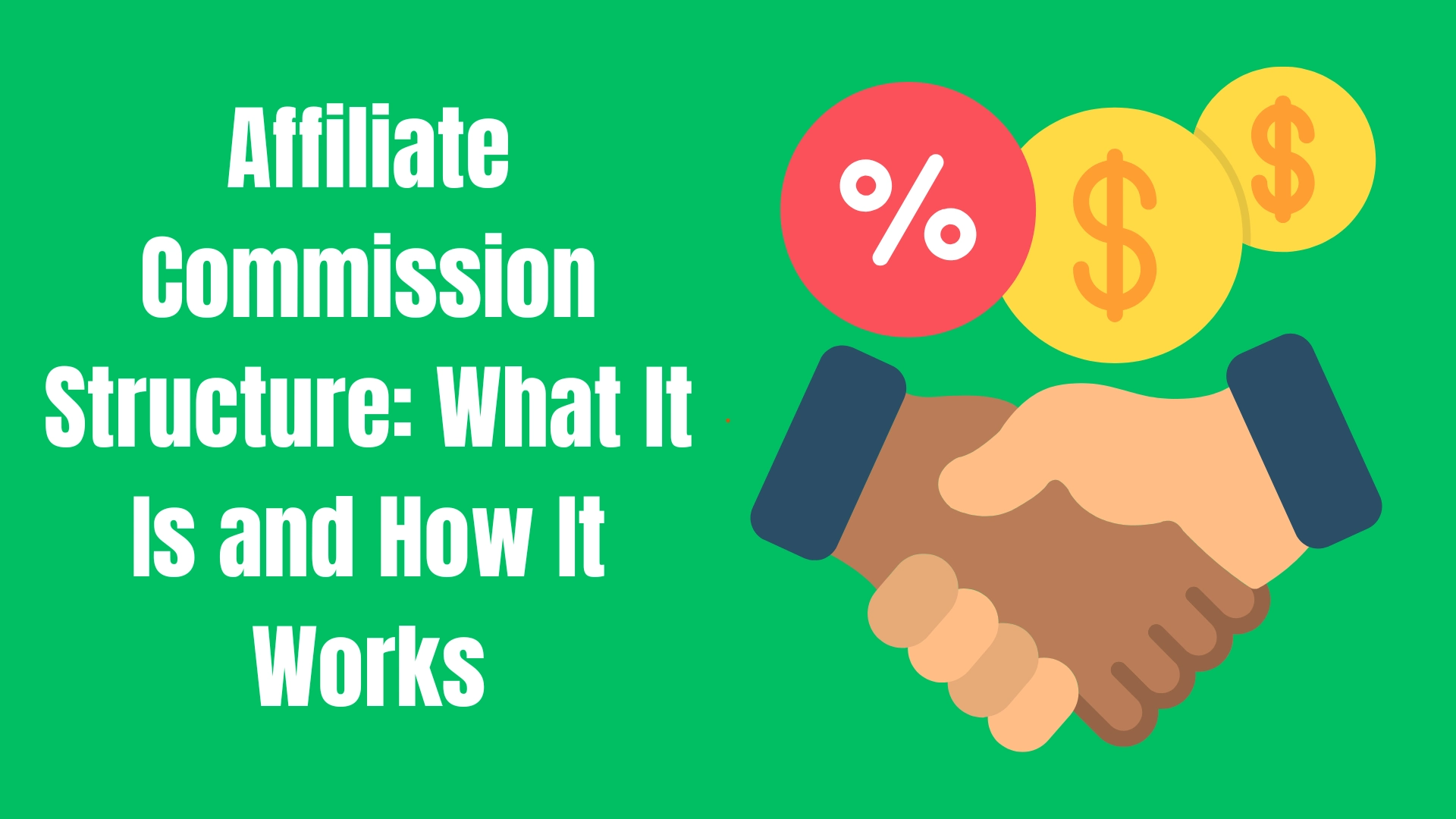Understanding the Affiliate Commission Structure: What It Is and How It Works

When I first started affiliate marketing, I had one big question — how do I actually get paid? I saw terms like CPA, revenue share, and tiered commissions, but they all sounded like a foreign language. I just wanted to know how much I’d earn for each sale.
If you’ve ever felt the same, don’t worry. Affiliate commission structures aren’t as complicated as they seem. They’re just different ways brands decide to pay affiliates. Some give you a flat fee per sale, others offer a percentage, and some reward you based on performance over time.
Understanding how these structures work is key to choosing the right programs. The wrong one can leave you working hard for pennies, while the right one can turn your efforts into serious income. In this guide, I’ll break down the most common commission models, how they work, and which ones are best for different affiliate strategies. Let’s get into it.
Key Takeaways
- Understanding different affiliate commission structures is key to maximizing earnings.
- The affiliate marketing industry is projected to grow significantly, highlighting its potential.
- Effective commission models can motivate affiliates and align them with business goals.
- Both flat fee and percentage-based commissions have their advantages depending on the product type.
- Regular assessment of commission rates can optimize affiliate performance.
- Knowing average commission rates helps in setting competitive offers for affiliates.
What Is an Affiliate Commission Structure?
In layman’s language, an affiliate commission structure is how brands pay affiliates for promoting their products or services. It’s the foundation of every affiliate program.
Instead of earning a fixed salary, affiliates get paid based on their performance, usually for each sale, lead, or action they drive. The commission model varies by program. Some offer a percentage of each sale, while others pay a flat fee per conversion.
For example, if a program offers a 30% commission on a $100 product, you earn $30 per sale. Some brands pay recurring commissions, meaning you keep earning as long as the customer stays subscribed. Others have performance-based tiers, where higher sales mean higher payouts.
Understanding these structures is crucial because not all programs are created equal. The right one can maximize your earnings, while the wrong one can leave you working hard for low payouts.
Importance of Affiliate Commission Structures
Affiliate marketing isn’t just about throwing links everywhere and hoping for the best. The way commissions are structured can make or break your success. Here’s why they matter.
They decide how you get paid: Affiliate programs have different pay. Some give a flat fee per sale, others pay a percentage, and some offer recurring commissions. If you don’t pay attention, you might spend months promoting something that barely pays anything. Always check before jumping in.
They shape your strategy: If you earn per sale, you’ll focus on high-converting content. If it’s pay-per-click, driving traffic is the priority. Recurring commissions? You’ll want long-term users. The structure determines how you market and what tactics work best.
They affect your earning potential: A 5% commission on a $20 product won’t pay much. But a recurring $10/month payout for each signup? That adds up fast. Choosing the right commission model can mean the difference between pocket change and real income.
Lastly, knowing the commission structure enables you to pick the right program: Some programs sound great until you see their terms. Low commissions, long payout delays, or strict rules can make them a waste of time. A good commission structure ensures your work pays off. Always read the fine print.
So, commission structures aren’t just details but they’re the foundation of your affiliate income. Know them, choose wisely, and set yourself up for success.
Common Types of Affiliate Commission Structures
Affiliate programs don’t all pay the same way. Some reward you for sales, others for leads or clicks. The key is choosing a structure that fits your strategy. Here’s a breakdown of the most common commission models:
1. Pay-Per-Sale (PPS)
Pay-per-sale is the most common commission model. You only get paid when someone makes a purchase through your link. The good news is that the payouts are usually higher because the company profits directly from each sale.
The disadvantage of this model is that if your audience clicks but doesn’t buy, you earn nothing. Many big brands, like Amazon and Shopify, use this structure. For example, if Amazon offers a 5% commission on electronics and someone buys a $1,000 laptop through your link, you pocket $50. Simple and straightforward, but it works best when you promote products people are ready to buy.
2. Pay-Per-Click (PPC)
Here, you earn money every time someone clicks on your affiliate link, whether they buy or not. It’s rare in traditional affiliate marketing but common in ad networks like Google AdSense.
Let’s say you run a blog with high traffic. If you place PPC ads on your site, you get paid for every valid click. The catch? Earnings per click (EPC) are usually low, often just a few cents to a couple of dollars. But with enough traffic, it adds up. This model is great if your audience clicks often but isn’t ready to buy.
3. Pay-Per-Lead (PPL)
You get paid when someone completes a specific action, like signing up for a free trial, filling out a form, or subscribing to a newsletter. This model is common in finance, insurance, and SaaS (software as a service).
For example, a credit card company might pay you $25 for every approved application. The advantage is that you don’t have to convince people to spend money, just to take action. However, some leads don’t convert into paying customers, so companies set strict rules to prevent fake or low-quality sign-ups.
4. Tiered Commission
The more sales you make, the higher your commission rate. This structure rewards top-performing affiliates with better payouts. Let’s say you start at 10% for your first 10 sales. Once you hit 50 sales, your rate jumps to 15%.
Some programs even have multiple levels, where you earn a percentage of commissions from affiliates you recruit. This model is great if you plan to scale, but it requires consistent effort to reach the higher tiers. It’s common in software and high-ticket programs, where companies want to keep top affiliates motivated.
5. Recurring Commissions
Instead of a one-time payout, you get paid every time a customer renews their subscription. This model is popular in SaaS and membership-based services.
For example, if you refer someone to a $50/month software with a 30% commission rate, you earn $15 every month for as long as they stay subscribed. Over time, this builds up into steady, passive income.
The bigger challenge is that it takes longer to see big earnings compared to one-time commissions. But if you promote quality services that people stick with, it’s one of the most profitable structures.
6. Percentage-Based
You earn a percentage of every sale, which means the more expensive the product, the higher your payout. This structure is common in almost every affiliate program. If a web hosting company offers 40% commissions and someone buys a $200 plan, you earn $80.
The disadvantage is that some companies have different rates for different products. You might earn 10% on one item and 30% on another. It’s a great model if you promote high-ticket items, but you need to choose programs wisely to maximize earnings.
7. Flat Fee
Instead of a percentage, you get a fixed payout per sale, lead, or action. Some programs pay $50 per sale, whether the product costs $100 or $1,000.
This model is common in VPN services, banking referrals, and app sign-ups. The good side of it is you know exactly what you’ll earn for each conversion. But if the flat rate is low, you might make less than percentage-based commissions on high-ticket products.
It’s best for programs with strong conversion rates and products people buy quickly without much hesitation.
Here is the summary:
| Commission Structure Type | Incentives | Example Commission Rates |
|---|---|---|
| Pay-Per-Sale (PPS) | Incentivizes high sales volume | 5% – 30% |
| Pay-Per-Click (PPC) | Encourages traffic generation | $0.01 -$3 per click |
| Pay-Per-Lead (PPL) | Reward lead generation efforts | $1 – $50 per lead |
| Percentage-Based | Incentivizes high sales volume | 5% – 30% |
| Flat Fee | Consistent, predictable earnings | $10 – $50 per sale |
| Tiered Rates | Motivates performance | Increases from 10% to 20% |
| Recurring Commissions | Strong for subscription services | 10% monthly |
How to Choose the Right Affiliate Commission Structure
Choosing the right affiliate commission structure can make a big difference in your earnings. Here are five points to help you decide:
1. Understand the Commission Types
The type of commission affects how you earn. With pay-per-sale, you only earn when someone buys through your link. Pay-per-click pays you for every click, even if no sale happens. Pay-per-lead gives you money when someone takes an action, like signing up for a newsletter. Choose the one that fits your content best.
2. Consider Your Traffic Volume
If your site gets lots of visitors, pay-per-sale might work well. But if you’re just starting and don’t have many visitors yet, pay-per-click might be better. You don’t need a sale, just clicks. The more traffic you have, the more money you can make with pay-per-sale.
3. Think About Your Audience’s Interests
Knowing your audience is very important. If you promote things your audience buys often, pay-per-sale can bring in higher earnings. If they’re more likely to click on things but not buy, pay-per-click could be a better option. Match your affiliate offers to what your audience values.
4. Check for Recurring Commissions
Some affiliate programs offer a recurring commission model. This means you get paid every month as long as the customer stays subscribed or keeps buying. It’s great for building a steady income. Look for offers that pay you long-term, not just once.
5. Compare Payouts and Payment Terms
Not all programs pay the same way. Some require you to hit a minimum before you get paid. For instance, Digistore24 has a minimum payout threshold of $50. Others might delay payment for a month or more. Make sure the payment terms suit your needs. If you need quick payouts, find programs that pay regularly.
By understanding these points, you’ll make better decisions on which affiliate commission structure works best for your site and goals.
Strategies for Increasing Affiliate Commissions
To boost affiliate earnings, promote high-paying programs. Not all affiliate programs pay the same. Some offer way better commissions than others. Do some digging and find ones that pay more for the same effort. A few good sales can beat dozens of low-paying ones.
Write honest and useful reviews. People don’t want fluff. They want to know if a product actually works. Share real experiences and honest opinions. If something sucks, say so. Your audience will trust you more, and that trust leads to more sales.
Use email marketing. Social media is nice, but emails sell. Build an email list and send valuable content, not just links. Warm up your audience before hitting them with offers. A good email sequence can bring in steady commissions.
Test and optimize your links. Some links perform better than others. Don’t just throw them everywhere and hope for the best. Track clicks, test different placements, and adjust things. A small change; like moving a link higher can greatly boost earnings big time.
Offer bonuses or extras. Give people a reason to buy through your link. A free guide, exclusive tips, or even a quick consultation can make a difference. If they get something extra, they’re more likely to buy from you instead of someone else.
Focus on recurring commissions. One-time sales are nice, but subscriptions pay you every month. Promote products with recurring commissions so you get paid long after the first sale. It’s a smart way to build passive income over time.
Challenges within Affiliate Commission Structures
Affiliate commission structures can be rewarding, but they come with hurdles. Understanding these challenges helps you avoid mistakes and maximize earnings. Here are five common issues affiliates face.
Low Commission Rates: Some programs offer tiny commissions, making it hard to earn a decent income. Selling a $50 product for a 3% commission means you earn just $1.50 per sale. Unless you drive massive traffic, low rates won’t cut it. Look for programs that pay fairly for your effort.
Delayed Payments: Many programs have long payout cycles. Some pay after 30, 60, or even 90 days. If you rely on affiliate income, these delays can hurt your cash flow. Always check the payment schedule before committing.
Changing Commission Structures: Some companies lower commissions without notice. You could be earning well today, then see your rates slashed tomorrow. This happens often with big retailers. Diversifying your income sources helps protect against sudden drops.
High Payout Thresholds: Some programs require you to earn a minimum amount before withdrawing. If the threshold is too high, you might wait months to see any money. Look for programs with lower limits or faster payouts.
Fraud and Rejected Commissions: Some affiliate programs don’t track sales properly or deny valid commissions. Others shut down accounts without explanation. To avoid this, work with reputable companies and keep records of your sales.
Despite these challenges, affiliate marketing is still one of the best ways to earn online. Read the fine print, test different programs, and adapt as needed. The right strategy will help you build a reliable income over time.
Conclusion
Affiliate commissions can make or break your earnings. The right structure depends on your traffic, audience, and strategy. Some programs pay once, while others keep paying as long as the customer stays.
The key is testing different models and tracking what works. One good adjustment can turn small commissions into a steady income.
Success in affiliate marketing isn’t about luck. It’s about knowing your audience and picking programs that match their needs. Start with what makes sense, then improve as you go. Stay patient, keep learning, and refine your approach. Over time, the right commission structure will reward you.
Frequently Asked Questions
What is an affiliate commission structure?
An affiliate commission structure is the payment system used by companies to reward affiliates for promoting their products. The most common types include pay-per-sale, where you earn a percentage of each sale made through your link, pay-per-click, which pays you for every click regardless of a purchase, and pay-per-lead, where you earn when a user completes an action like signing up for a free trial. Choosing the right structure depends on your audience, traffic, and marketing strategy.
Which commission structure is best for beginners?
If you’re new to affiliate marketing, pay-per-click and pay-per-lead programs might be easier since they don’t require a sale. These allow you to earn even if your audience isn’t ready to buy. However, pay-per-sale programs usually offer higher payouts and long-term earning potential. If you have an engaged audience that trusts your recommendations, starting with a mix of all three can help you figure out what works best.
How do I know if a program has a fair commission rate?
A fair commission rate depends on the product price, demand, and how much effort it takes to sell. Compare rates across different programs in your niche. High-ticket items usually have lower percentage commissions, while digital products often offer higher rates since there are no production costs. Also, check if the program provides recurring commissions, which can generate passive income over time.
Why do some programs delay payments?
Many companies hold payments for 30, 60, or even 90 days before releasing funds. This waiting period helps them verify legitimate sales, handle possible refunds, and protect against fraud. While this is common, you should always check a program’s payout schedule before joining. If you need faster payments, look for programs that offer weekly or bi-weekly payouts.
Can I earn passive income from affiliate commissions?
Yes, some affiliate programs offer recurring commissions, meaning you get paid monthly as long as the customer stays subscribed. This is common with software, memberships, and subscription-based services. Promoting products with lifetime or recurring commissions can create a steady income stream. Instead of making one-time sales, you continue earning as long as the customer remains active.
What should I do if my commissions aren’t tracked correctly?
Sometimes sales don’t track properly due to browser issues, cookie settings, or technical glitches. If you notice missing commissions, contact the affiliate program’s support team with proof of your referrals. Use tracking tools like UTM links or affiliate dashboards to monitor clicks and conversions. Keeping records of your traffic and referrals helps you dispute missing payments and ensure you get credited for your efforts.






